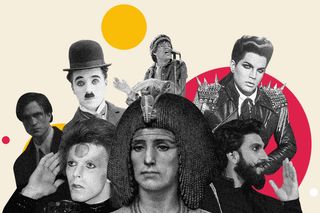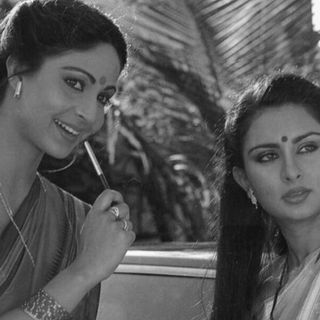
‘Guyliner’: A Brief Cultural History
Guyliner, to this day, remains a tool men use to assert, glorify and celebrate their deviance, often flouting traditional norms of masculinity in the process.

This week, DC Films released the first trailer for the Robert Pattinson-starring The Batman, in which the British actor has visibly disentangled himself from the quintessential Batman aesthetic, particularly emboldened by his smokey eyes ringed with kohl. It’s why fans all around the world objectified and lusted after Pattinson with unadulterated fervor this week — the smudged eyeliner, or more specifically, the ‘guyliner.’ It’s one element of make-up that men have readily embraced, not just in the gender fluid-reality of today, but as far back in time as Ancient Egypt. Men across centuries have used the guyliner to assert their identities, to set themselves apart from the common, and later, mainstream folk. The guyliner, to this day, remains a tool men use to assert, glorify, and celebrate their deviance, often flouting traditional norms of masculinity in the process.
In Ancient Egypt, as early as 2200 B.C., all upper-classmen sported elaborate, cat eye-style kohl liners on their eyes, partly for kohl’s medicinal properties that warded off bugs and kept inflammation at bay, and partly as a sign of their elevated social stature. While research shows men from all social classes wore some semblance of eye protection in the form of eyeliner (be it expensive kohl or commonly-found soot), the intricacy and style of the eyeliner was definitely something Egyptian pharaohs used as a visual element of their appearance that was supposed to set them apart from the masses, as a unique identifier, to convey their power and position.
Fast forward to the early 1900s, and we see that make-up had become quite a gendered concept, predominantly accepted only when used by two groups — sex workers and actors. Even here, we see the guyliner popular amongst those who displayed a certain ‘otherness,’ either in their background or in their work. Be it Rudolph Valentino, an immigrant actor-slash-heartthrob, who was constantly portrayed by critics as too effeminate, too ‘other,’ fuelled no doubt by his status as a foreign-born artist living in America, or Charlie Chaplin, who embodied deviance not just in his cartoonish comedy, but also in his politics, and in his appearance (with guyliner). These artists’ choice to wear eyeliner, however, never really caught on, especially after their art forms radically changed to cater to the mainstream, the masculine and macho dude with the onset of the talkies in Hollywood.
Related on The Swaddle:
A to Z: A Concise Dictionary of Unfeminist Fashion
But Black artists in the 1950s, such as James Brown, rebirthed the look, albeit in soft, subdued tones categorized by a tight, thin line around the eyes, mostly in an attempt to bring definition to their eyes and add to their handsomeness. Male artists taking to make-up — predominantly considered the woman’s dominion — was still revolutionary, no matter how subtly they delivered the message. It was around this time that the counter-culture movement took shape, essentially giving a lift to all things deviant, ‘other’ and unconventional. The unassuming guyliner quickly became a rock-and-roll staple, now available to all artists who wanted to glory in their deviance, in a new fabric of society that was learning to accept and embrace the alterna-male archetype.
Enter the glam rock stars of the ’70s — David Bowie, Prince, Mick Jagger — who weren’t afraid to look effeminate, to look the part of the ‘other,’ but instead embraced, even branded themselves as deviant, often going all out not just with the guyliner, but with the face paint and gender-fluid clothing and mannerisms. This wholehearted embrace of the guyliner also opened the tool up for interpretation and innovation by other sub-cultures emerging during the time, such as the punk movement embodied by the likes of the Sex Pistols and The Clash. These bands wielded their choice of clothing and make-up to further solidify anti-authoritarian ideologies, in which the thick, dark guyliner became a mainstay.
In the next couple of decades, the guyliner became quite versatile. Now that it was already popular and commonplace, artists started using guyliner not just to assert their deviant personalities and art, but also what it could say about their character — we saw some lean into the femininity of it all, such as The Cure’s Robert Smith or Aerosmith’s Steven Tyler who, at the time, was known for his perfect cat-eye. On the other end were the artists who used the guyliner as an addition to enhance their bad-boy masculinity, such as The Rolling Stones’ Keith Richards, sporting messily drawn-on guyliner showing his utter nonchalance as a rock superstar. The 00’s, also called the ‘era of the guyliner,’ saw Green Day’s Billie Joe Armstrong lean into the under-eye smudge, Fall Out Boy’s Pete Wentz start his own trend with clear, clean lines, and Panic! At The Disco going all out in full eyeliner and eyeshadow artistry, often paying visual homages to artists like Bowie in their shows.
And in the ’00s is where the guyliner has idled as a concept, wrung out by all kinds of musicians, artists and actors, interpreted in several different ways to mean several different things, until the guyliner ceased to become alternative, as deviant or as part of a counter-culture. That is, until you come to India.
Related on The Swaddle:
Ranveer Singh Is Mainstreaming Dandyism
India has had a long history of men darkening their eyes using soorma. It’s used in many different cultures in the country to ward off the evil eye, to improve eyesight (due to the medicinal properties of the kind of kohl used), especially in Muslim communities. Unfortunately in Bollywood, the soorma has now single-handedly come to denote a character as Muslim, as a reductive stereotype in pop culture. While the cultural reasons for why men in India darken their eyes are markedly different from the history of the guyliner in the rest of the world, the pop-culture depictions of men wearing eyeliner still fall into the trap of deviance and otherness as reflected by men of centuries past. In India, we see the trend buried in a much more sinister context. Be it Ranveer Singh’s Alauddin Khilji in Padmavati, or his Murad in Gully Boy, male actors who play Muslim characters have always been marked with the soorma, which come off as lazy, stereotypical depictions. And as Islamophobia runs deep in the fabric of contemporary India, we also see these same kohl-eyed Muslim men shown as menacing, dangerous, primitive, poor, or as criminals. The reclaiming of identity that is so central to the concept of the guyliner in history, it seems, has clearly evaded the sensibilities of the modern filmmaker in India.
But a certain change is definitely afoot offline, embodied almost singularly in Bollywood by Ranveer Singh, who Nadia Nooreyezdan calls a gender-bending, modern-day dandy on The Swaddle. Singh is not only seen casually sporting the guyliner on a regular basis but also showing off kimono dresses and silk blouses, essentially breaking the conventions of traditional masculinity and normalizing men putting time, energy, and personality into their appearance. A similar trend celebrating gender fluidity has already taken off on platforms like Tik Tok, with men taking up space in the make-up tutorial industry, demonstrating not just how to do the perfect cat-eye, but how to embrace make-up as a whole.
And that’s why the guyliner is not necessarily where we need to direct our attention going forward. At least in the rest of the world, it essentially died as a counter-culture element by the end of the ’00s, simply because it became too ubiquitous, mainstream to signal an alterna archetype. It’s exemplified by how someone like Pattinson could land the role of a historically masculine superhero and be almost unanimously welcomed, applauded for it.
Perhaps where we need to look now is not a small visual element like the guyliner, but at the norms of gender and sexuality that are increasingly blurring, becoming fluid, opening up entire avenues of aesthetic expression to men they didn’t have access to before. It’s a world in which the guyliner is almost pedestrian, expected, and a man’s right to wear it is secure.
As pop artist Dorian Electra is already singing in his 2019 pop release “Guyliner” — “I’m a guy/Don’t be surprised/If I take my time to glamorise/No reason why/That I can’t try/To line my eyes/It feels so right/Yeah, you know I’m wearing/(Guyliner) Yeah, and everybody’s staring/(Guyliner) This is the real me baby, and this ain’t no disguise.”
And we’re here for it.
Rajvi Desai is The Swaddle's Culture Editor. After graduating from NYU as a Journalism and Politics major, she covered breaking news and politics in New York City, and dabbled in design and entertainment journalism. Back in the homeland, she's interested in tackling beauty, sports, politics and human rights in her gender-focused writing, while also co-managing The Swaddle Team's podcast, Respectfully Disagree.
Related


Goa Is Now Open For Tourism. But Does That Mean We Should Go?
